Richard Howland Hunt
Richard Howland Hunt (March 14, 1862 – July 12, 1931) was an American architect and member of the Hunt family of Vermont who worked with his brother Joseph Howland Hunt in New York City at Hunt & Hunt.
Richard Howland Hunt | |
|---|---|
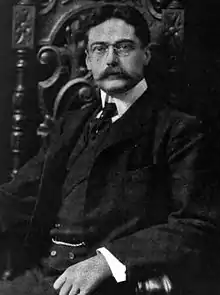 | |
| Born | March 14, 1862 |
| Died | July 12, 1931 (aged 69) |
| Resting place | Newport, Rhode Island[1] |
| Alma mater | Massachusetts Institute of Technology École des Beaux-Arts |
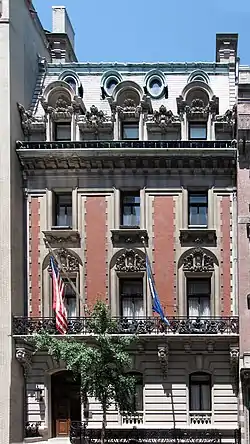
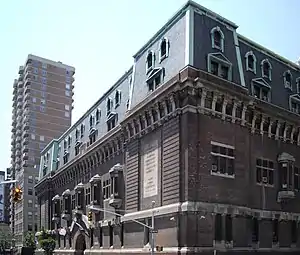
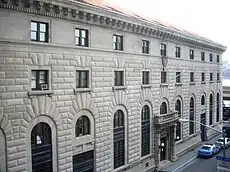
The brothers were sons of Richard Morris Hunt, the first American Beaux-Arts architect. Richard practiced in his father's office until the elder Hunt died in 1895, then continued to carry out his father's designs for the central block of the Metropolitan Museum of Art,[2] not without initial resistance by the museum's trustees.[3] In 1901, the brothers formed a partnership[4] that lasted until Joseph's death in 1924.[5]
Early life
Hunt was born on March 14, 1862, in Paris, where his father, Richard Morris Hunt (1827–1895), was completing his architectural studies. His mother, Catherine Clinton Howland (1841–1880), was the youngest daughter of the prominent merchant Samuel Shaw Howland of Howland & Aspinwall. His siblings were Catharine Howland Hunt (wife of Rear Adm. Livingston Hunt, son of William H. Hunt), fellow architect Joseph Howland Hunt,[5] Esther Morris Hunt (wife of George Muirson Woolsey),[6] and oilman Herbert Leavitt Hunt (who married Evelyn Frances Bell).[7][8]
Hunt studied architecture at the Massachusetts Institute of Technology and the École des Beaux-Arts, Paris, where his father had studied. His younger brother Joseph studied at Harvard College and the School of Architecture at Columbia University before following his brother to the École des Beaux-Arts, returning to New York in 1901.[5]
Career
In 1887, Richard Hunt joined his father's offices, first as a draftsman and later an associate. After his father's death, he attracted wealthy clients and built residences such as the Margaret Shepard house at 5 East 66th Street in 1900 (today home to the Lotos Club).[9]
Urban residences by Hunt & Hunt include the two Beaux-Arts houses designed for George W. Vanderbilt at 645 and 647 Fifth Avenue, known as The "Marble Twins". Only No. 647, a designated New York City Landmark, survives today.
The brothers were primarily known for their elegant residences in Long Island, Tuxedo Park, New York, and Newport, Rhode Island. Their armory building for the 69th Regiment, New York, was the first armory to abandon pseudo-medieval crenellations.
Hunt & Hunt projects
- Alumnae House and Williams House, Vassar College. 1924. Half-timbered construction.[10]
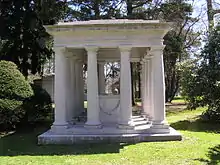
- Memorial and sarcophagus for playwright Clyde Fitch at Woodlawn Cemetery in The Bronx, New York City, 1910s.
- George Washington Vanderbilt Houses, 645 and 647 Fifth Avenue, New York, called the "Marble Twins." 1902-05. Number 647 survives, a designated landmark, as the flagship store for Versace;[11] the site of 645 is now Olympic Tower.
- Forest Hall, Milford, Pennsylvania. 1903. For James Pinchot, for whom Richard Morris hunt had built Grey Towers. (National Register of Historic Places)
- Sanderson estate, Oyster Bay, New York.[12] (1885).[13]
- St. Mary's-in-Tuxedo Episcopal Church Rectory, Tuxedo Park, New York.[14] 1895.[15]
- 69th Regiment Armory, between 25th and 26th Streets and Lexington and Park Avenues. 1903-06.[16]
- Saddle Rock House, Shippan Point, Connecticut, 1914, for inventor Thomas Robins.[17]
- Terre Bonne, Shippan Point, Connecticut, 1914, for pioneer filmmaker/movie producer Frank J. Marion.[18]
- Edward Harden Mansion, Sleepy Hollow, New York, 1909.
- Sabine Farm Greenwich, Connecticut, 1910, for publisher H. J. Fisher [19]
- First Precinct Police Station, New York. 1909-11.
- Amos R. E. Pinchot House,[20] Park Avenue at 85th Street. 1910.[21]
- Beacon Towers, Sands Point, New York, 1917–18, for Alva Belmont. It was their last commission on the Gold Coast.[22]
Collaborations with sculptors
As did many of the architects of the time, Hunt & Hunt designed bases and pedestals for sculptors. These include:[23]
- William McKinley Monument by Charles Mulligan, Chicago, Illinois, 1905
- Sighting the Enemy for Edward Clark Potter in Monroe, Michigan, 1910
- Lafayette Monument by John Ferguson Weir, Milford, Pennsylvania
References
Notes
- "Richard Howland Hunt, New York City Deaths". familysearch.org.
- Hunt was unable to persuade the Museum's trustees to complete the sculptural groups. Bogart, Michele H. Public Sculpture and the Civic Ideal in New York City 1989:158-65
- Baker, Paul R. Richard Morris Hunt Cambridge, Massachusetts: MIT Press 1980:442ff.
- Landmarks Preservation Commission: First Precinct Police station, 20 September 1977 Accessed 2 December 2008. Basic biographical details.
- "JOSEPH H. HUNT DIES, NOTED ARCHITECT.; President of Municipal Art Society a Victim of Pneumonia at 54 Years. !". The New York Times. October 12, 1924. Retrieved 25 June 2021.
- "GEORGE WOOLSEY, S.P. C. A. HEAD, DIES; President of Society Since 1932 Held Many Offices in Organization". The New York Times. April 23, 1937. Retrieved 25 June 2021.
- TIMES, Special Cable to THE NEW YORK (December 2, 1908). "HUNT LOSES SUIT FOR GIFTS.; Referee Holds That Wedding Presents Were Given to Him and Wife Jointly". The New York Times. Retrieved 25 June 2021.
- "MRS. H. L. HUNT. DEAD; Wife of Oil Man Was Trustee! of Mary Baldwin College". The New York Times. May 8, 1955. Retrieved 25 June 2021.
- White, Norval & Willensky, Elliot (2000). AIA Guide to New York City (4th ed.). New York: Three Rivers Press. ISBN 978-0-8129-3107-5.
- historic CVampus Architecture Project: Alumnae House.
- Gray, Christopher. "Streetscapes: 647 Fifth Avenue; A Versace Restoration for a Vanderbilt Town House" The New York Times (April 9, 1995) accessed 2 December 2008.
- Library of Congress.
- Milford Heritage Tour.
- Crofut, Doris (1975). St. Mary's-in-Tuxedo, 1888-1975. Tuxedo Park, NY: Library Research Associates Inc. p. 11. OCLC 2006112.
- "A Tour of Our Campus". Retrieved July 12, 2021.
- The armory.
- The Architectural Record November 1916, Three Connecticut Country Houses, Vol XL No 5
- New York Times, October 2, 2005, Real Estate section, "A Neighborhood to Move Around In", by Lisa Prevost.
- "9 Sabine Farm Road Greenwich, Connecticut, United States – Luxury Home For Sale". www.sothebysrealty.com. Archived from the original on 2017-11-03.
- Pinchot was the brother of the conservationist Gifford Pinchot, superintendent of the forest surrounding Biltmore, built by Richard Morris Hunt for George Washington Vanderbilt, completed by Richard H. hunt in 1896.
- Trager, James. Park Avenue, Street of Dreams (Atheneum, 1990).
- MacKay, Robert B.; Anthony K. Baker; Carol A. Traynor (1997). Long Island Country Houses and Their Architects, 1860-1940. New York: Society for the Preservation of Long Island Antiquities in association with W.W. Norton & Co. pp. 231–232. ISBN 978-0-393-03856-9.
- Search results: "Hunt & Hunt, architectural firm" on the Art Iventories Catalog of the Smithsonian American Art Museum via the Smithsonian Institution Research Information System
Bibliography
- Mackay, Robert; Baker, Anthony; and Traynor, Carol eds. Long Island Country Houses And Their Architects 1860 to 1940
External links
 Media related to Richard Howland Hunt at Wikimedia Commons
Media related to Richard Howland Hunt at Wikimedia Commons